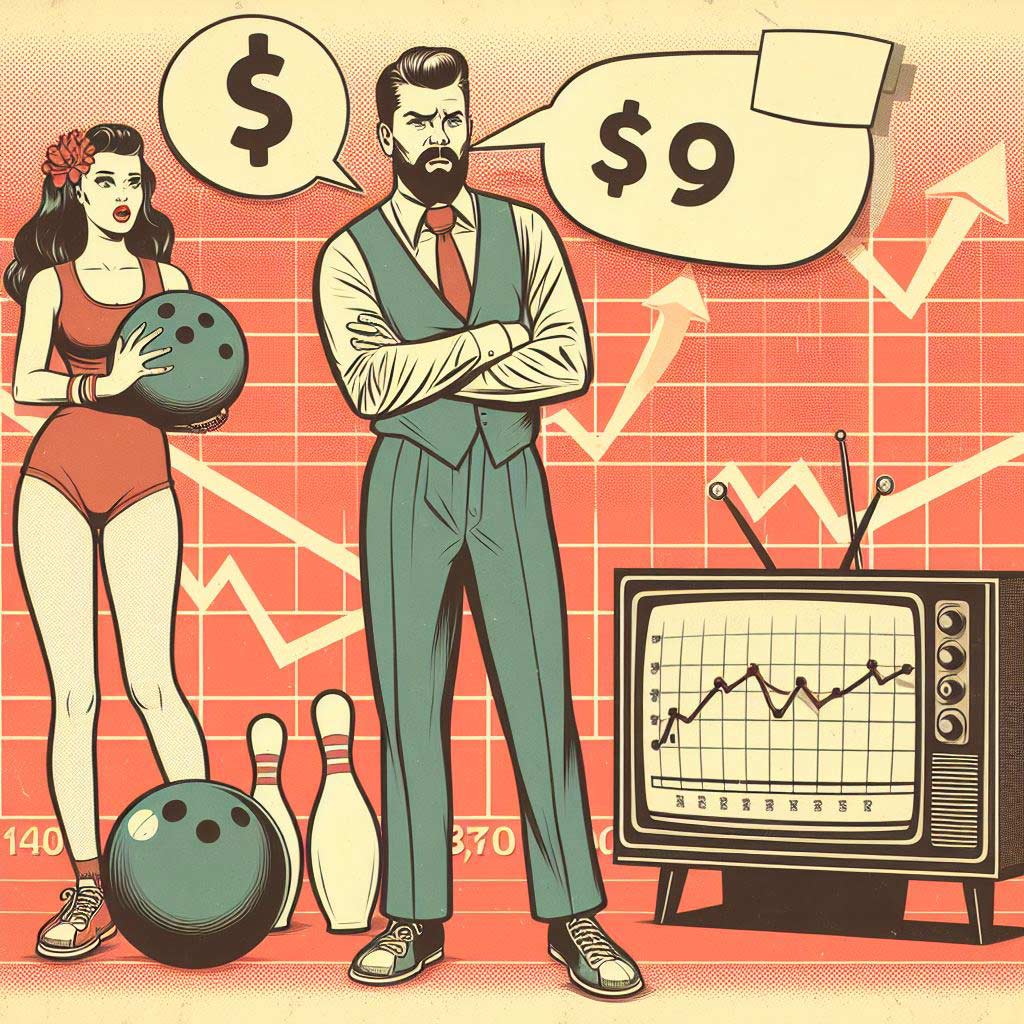The sticker shock of seeing a $5-10 per person per game price tag at your local bowling alley might make you wonder – why is bowling getting so expensive?
With nostalgic memories of affordable birthday parties from our childhood, many bowling enthusiasts have questioned if the beloved sport is pricing out everyday players.
Between rising bowling ball prices to seemingly always increasing hourly lane rates, avid bowlers have found the financial commitment required to play has rapidly outpaced inflation over the past several decades.
So what exactly is driving the rising cost of your average trip to the bowling lanes? Below we’ll analyze the key factors that make running an operational bowling alley such a capital and labor-intensive small business.
Gaining insight into the various equipment, real estate, employee and general overhead costs can help explain why merely a night out bowling for the family now requires a significant recreational budget.
The Expensive Reality of Operating a Bowling Alley
With massive indoor spaces filled with intricate machinery, specialized rental equipment, and on-site dining/entertainment venues, bowling alleys reflect closer to the operational scope of hotels rather than simple recreational sports complexes.
According to industry analysts, a brand new 40-lane bowling alley built today would cost between $7.5 – $12 million to construct and equip before even factoring in recurring expenses.
Real Estate Overhead
Finding adequate real estate parcels properly zoned, accessible by patrons, and located to mitigate noise complaints already makes opening a new bowling venue tremendously location-dependent.
Construction costs directly correlate to the retail price per square foot – meaning bowling alley owners in dense metro downtowns or popular suburban complexes often pay exponentially higher base rates than their counterparts in rural regions simply due to supply and demand dynamics.
Ongoing utility bills and property taxes reflect these geographical cost differences as well throughout decades-long mortgages.
For established bowling centers not actively upgrading facilities, baseline rents, renovations, taxes, and assorted property management fees account for approx. 8-12% of total operating expenses on average.
Specialized Building & Lane Maintenance
The heart and soul of any bowling alley lies in the quality and consistency of its lanes.
Yet the specialized equipment and patented technology powering modern bowling components – called the ‘pinsetter’ – requires intensive capital investment and continual maintenance not found in most other small businesses.
Pinsetters alone cost between $10,000 – $15,000 per lane to install. The fragile nature of core bowling machinery containing complex mechanisms, moving parts, and electronics causes pinsetter breakdowns too frequently for comfort.
Many alley owners report needing a full-time mechanic on staff to handle abrupt failures causing lane shutdowns at their center.
Add in costs for lane resurfacing ($5,000+ per lane), quarterly oil/conditioning, scoring displays, seating units, and more – suddenly major renovations or updates easily swell into the $500,000+ range for small-to-midsize bowling alleys.
Skilled Staffing Roles
Quality customer service and execution provide the glue holding successful modern bowling alleys together. Yet skilled labor proves both essential and hard to consistently recruit long-term.
Front desk staffers need extensive training in bowling terminology, scoring fluency, equipment fitting, managing reservations plus general service qualifications to handle visitors’ wide range of requests and conflicts.
On the facilities side, the specialized equipment knowledge needed by technicians and mechanics around safe pinsetter operation and repairs generally demands substantial initial training plus ongoing licensing.
Ball drilling and pro shop experts represent another niche role many bowling alleys need filling to optimize consumer experiences.
Balancing competitive hourly wages with retention incentives across high-turnover entry-level and specialized roles makes controlling overhead labor costs extremely tricky for many struggling alley owners – especially those lacking brand recognition or stable league commitments.
Surging League Bowling Decline
Leagues and loyal league bowlers once provided the financial backbone buoying many local bowling centers, with guaranteed weekly business filling open lanes and bowling shops with relatively recession-proof consistency.
Yet USBC statistics show that formally registered bowling league participants across the country have decreased by nearly 40% over the past decade – dropping from just over 1.7 million members in 2010 to slightly more than 1 million by 2020.
Without this assured customer base making weekly outings part of their lifestyles for upwards of 30+ straight weeks annually, many alleys lose critical revenue stability.
Attempts to replace leagues through corporate events, birthday parties, walk-in families, and sporadic bowlers fail to replicate the tremendous historic value leagues brought through volume, predictability, and ancillary bowling equipment sales/services.
Factor in league contract negotiation complexities around lane pricing packages and time commitments and the picture looks even more challenging for alley owners. Many have had to make tough decisions reducing off-peak league subsidies to stay financially viable.
Ongoing Upgrades & Training to Stay Competitive
Surviving operators understand resting on the status quo will accelerate their decline amid ever-expanding entertainment options.
Customers expect continually modernized experiences – driving veteran bowling alley owners to make major ongoing investments in maintaining relevance in the digital age.
State-of-the-art scoring systems now enable online reservations, instant video replay screens, bumper bowling for kids, and analytics for experienced bowlers.
Interactive games and visual upgrades keep bowling stimulating across wider demographics than historically targeted leagues.
Enhancements extending to on-site amenities like arcades, billiards, dining, and even full-service bars help transform alleys into destination entertainment hubs ideal for corporate team building.
Yet all these upgrades bring incremental costs making niche differentiation ever more essential.
Industry experts estimate family entertainment centers focused on attracting younger crowds should budget approximately 10-15% of gross revenues toward new games, attractions and modernizations continually.
Surviving operators running upgraded bowling venues now essentially oversee amusement park-like facilities minus the weather concerns.
Ongoing staff training also proves essential as consumer expectations heighten alongside alley upgrades.
Customer service focus for frontline workers shifts away from strictly clerical tasks toward fostering repeat visits through positive visitor experiences among increasingly casual bowlers.
That requires expanding skill sets around instruction, equipment recommendations plus general activity facilitation absent among veteran league staffers.
Inflation Multiplier Effect
As outlined above, the very nature of operating a profitable modern bowling alley leaves extremely narrow margins for error in containing costs.
When variable expenses face relentless inflationary pressures within the wider economy, significant price increases become necessary simply to tread water.
Everything from replacing rental shoes more frequently, and restocking ball/lane supplies to paying coaches and front desk staffers living wages comes at continually elevated reinvestment rates in 2023’s economy compared to decades past. And rising prices can only climb so high before participation rates drop, creating a detrimental cycle.
Veteran alley owners eagerly remember offering $1 games and $0.50 shoe rentals back in the 1970s when America’s love affair with bowling reached its televised peak.
Yet the days of promotional $1 alcohol drafts or $0.25 hot dog specials will likely never return without significant industry subsidies.
This leaves passionate supporters forced to pay fair market rates if they wish to keep their favorite local alley open at all.
The Search for Modern Bowling Discounts
In fairness, pure profit greed fails to tell the whole story from struggling bowling alley owners’ perspectives in most cases.
Yes, prime Saturday evening bookings may command staggering lane rates to capitalize upon demand spikes. But carefully tracking social media promotions and Membership reward programs can yield notable cost savings during off-peak blocks for savvy bowlers.
Industry analysts confirm many alleys now implement dynamic pricing models similar to airfare or hotels.
Unpopular weekday mornings traditionally see the lowest lane rates industrywide – allowing flexible patrons to enjoy serious cost savings while avoiding noisy crowds.
Setting Google Alerts for targeted local alley deals provides another pro tip for saving on spontaneous bowling outings.
League lifers rightfully argue they unfairly bear rate hikes after years of supporting old centers with rote consistency. This leads opportunistic newer alley concepts into this fray hoping to disrupt market rates with boutique experiences.
Many bowling industry innovators now test smaller venues featuring 8-12 lanes with hip styling, cutting-edge tech, and experimental formats like black-light bowling.
Lower operating overhead allows niche concepts to potentially keep prices below shrinking local centers clinging to outdated business models.
Bowling Industry Future Outlook
Incorporating decades working around America’s classic bowling alleys, industry veterans sadly understand why astronomical price leapfrogs leave casual visitors questioning if they can even afford occasional games anymore.
Yet looking closer at real inflationary overhead trends shows why continually rising rates remain essential for most basic bowling centers to survive modern challenges.
With uncertainties around leagues and consolidation ever-present, niche boutique bowling concepts do offer optimism if succeeding in attracting younger generations through adrenaline-fueled Instagram moments.
However, many anchors closing down after generations as community staples signal adjustments necessary by consumers and businesses to sustain the sport so culturally intertwined with Americana.
Support local favorites through peak pricing times or get comfortable paying higher premiums to roll in style – either becomes necessary to keep cherished bowling alleys striving through 2023 and beyond.
Frequently Asked Questions
Is bowling an expensive sport?
Bowling can be considered an expensive sport due to the high overhead costs of operating bowling alleys. Between specialized equipment, real estate, and staffing, overhead costs are quite high compared to other recreational sports. These costs then get passed onto consumers through lane rental rates and other fees. Casual bowlers typically spend $5-$10 per game which can add up quickly. More competitive players invest in equipment, league fees, and practice time which also raises the cost.
Why are bowling reservations so expensive?
Bowling reservations at peak times (weekends, holidays) come at premium prices due to high demand. Limited lanes mean alley owners maximize profits by charging more when many groups want to book. Reserving a lane also guarantees access so prices reflect that convenience. Off-peak bowling reservations on weekdays come at significantly lower costs in many areas due to a lack of demand.
How long does it take to bowl 1 game?
One standard game of bowling takes between 12-15 minutes for most players. This factors in drive time between frames. Experienced league players often bowl closer to 10-minute games due to familiarity with equipment, pace, and lane courtesy awareness.
Where is bowling most popular in the world?
Bowling remains most popular in the United States based on the number of bowling centers and league/casual players. Demand peaked in the mid-20th century and has declined since but the US still dominates participation globally. Other leading bowling countries include Japan, South Korea, Canada, and Germany.
What sports cost the most money? Golf, hockey, and equestrian sports (like polo) rank among the most expensive sports globally based on required equipment, training, and competition access costs. Their exclusivity also factors into historically high consumer pricing.
What sport is more expensive?
Compared to similar recreational sports, bowling tends to cost more per game session than comparable baseball batting cages, billiards/pool, or basketball if you already own equipment. The overhead disparity between massive specialized bowling alleys versus more modular courts/ranges creates this pricing difference.
Why do people like bowling?
People enjoy bowling for athletic competition against friends in a social, indoor environment. Its simplicity attracts wider age ranges and abilities. Bowling also appeals as recreation after dinner/drinks as a classic group night option combining activity with food, drinks entertainment under one roof.
How much does it cost for bowling at Village Market?
According to recent rates listings, Village Market charges between $4.50-$7 per game per person depending on peak vs. non-peak session times. Shoe rentals run $6 while ball rentals cost $4.50 as of the end of 2022.
How much is bowling at Carnival?
Published Carnival cruise line bowling rates show guests can expect to pay between $4-$8 per person per game across their fleet ships. This rate includes shoe rental but ball rental fees cost around $2.50. Peak times see higher lane rates plus potential wait times.





